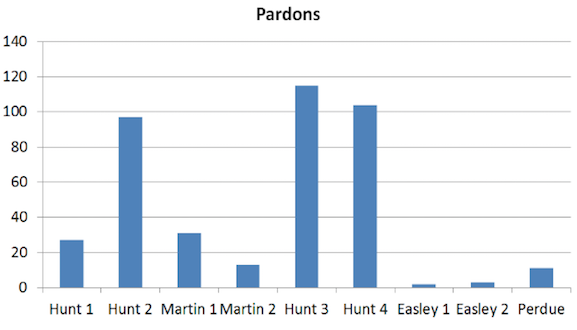Rascals case in brief
In the beginning, in 1989, more than 90 children at the Little Rascals Day Care Center in Edenton, North Carolina, accused a total of 20 adults with 429 instances of sexual abuse over a three-year period. It may have all begun with one parent’s complaint about punishment given her child.
Among the alleged perpetrators: the sheriff and mayor. But prosecutors would charge only Robin Byrum, Darlene Harris, Elizabeth “Betsy” Kelly, Robert “Bob” Kelly, Willard Scott Privott, Shelley Stone and Dawn Wilson – the Edenton 7.
Along with sodomy and beatings, allegations included a baby killed with a handgun, a child being hung upside down from a tree and being set on fire and countless other fantastic incidents involving spaceships, hot air balloons, pirate ships and trained sharks.
By the time prosecutors dropped the last charges in 1997, Little Rascals had become North Carolina’s longest and most costly criminal trial. Prosecutors kept defendants jailed in hopes at least one would turn against their supposed co-conspirators. Remarkably, none did. Another shameful record: Five defendants had to wait longer to face their accusers in court than anyone else in North Carolina history.
Between 1991 and 1997, Ofra Bikel produced three extraordinary episodes on the Little Rascals case for the PBS series “Frontline.” Although “Innocence Lost” did not deter prosecutors, it exposed their tactics and fostered nationwide skepticism and dismay.
With each passing year, the absurdity of the Little Rascals charges has become more obvious. But no admission of error has ever come from prosecutors, police, interviewers or parents. This site is devoted to the issues raised by this case.
On Facebook
Click for earlier Facebook posts archived on this site
Click to go to
Today’s random selection from the Little Rascals Day Care archives….
Click for earlier Facebook posts archived on this site
Click to go to
Today’s random selection from the Little Rascals Day Care archives….
A lack of reporters ‘sufficiently passionate to get at this story’?

thetennessean.com
Frank Daniels III
July 8, 2016
“As for an ‘investigative’ piece about the Kelly case that would get to the ‘truth,’ we will have to see if we have any staff members who are sufficiently passionate to get at this story….”
– From News & Observer executive editor Frank Daniels III’s reply (June 10, 1992) to a plea for coverage from Jane W. Duffield of the Committee to Support the Edenton Seven
Daniels’ predecessor, Claude Sitton, lamented later that “my greatest mistake (was) my failure as editor… to make sure we had a top-notch investigative reporter on the Little Rascals case.”
I’ve asked Daniels to share his own recollections of the paper’s coverage, but haven’t heard back.
![]()
Clemency now rare; is it fear of blowback?
 Dec. 8, 2013
Dec. 8, 2013
“Obviously, there’s a modern trend towards more limited use of executive clemency that extends beyond the current president. I speculate that the increased media scrutiny given to pardons and commutations has made presidents reluctant to exercise clemency…..
“The same trend… may be present in North Carolina as well…. Most of Governor Easley’s pardons were in cases in which DNA evidence exonerated the defendant, while almost all of Governor Perdue’s pardons concerned the racially tainted Wilmington 10 cases…. It is too early to tell how much, or how little, Governor McCrory will exercise executive clemency.”
– From “Do Only Turkeys Get Pardons?” by Jeff Welty at the North Carolina Criminal Law blog (Dec. 5)
The chart above, compiled by Welty, a faculty member at the University of North Carolina School of Government, depicts poignantly the odds faced by Junior Chandler and others pursuing clemency from recent North Carolina governors.
Since Jim Hunt left office in 2001, pardons have become historically scarce, paralleling the drop-off at the presidential level. But that smattering of clemency, as Welty points out, is most like to occur in December, under cover of the Christmas spirit.
Dog bites man: ‘Paper will not be retracted’
 Aug. 26, 2015
Aug. 26, 2015
In November 2012 the journal Nursing Research declined my request to retract Susan J. Kelley’s 1990 article based on the existence of “satanic ritual abuse” in day cares. The editor contended that “Conditions that would lead to a retraction are not present.”
Nursing Research having since installed a new editor, I recently tried again. This time I was able to include two important academic developments: Richard Noll’s expose of the “satanic ritual abuse” movement in Psychiatric Times and Dr. Allen Frances’ personal apology for failing to do more to challenge that movement.
This is an excerpt from the response I received from editor Susan J. Henly, professor emerita, University of Minnesota School of Nursing:
“As I understood it, your argument for retraction (of ‘Parental Stress Response to Sexual Abuse and Ritualistic Abuse of Children in Day-care Centers’) was based on the rationale that: the title embraced and promoted the existence of ritual sexual abuse in day cares that did not exist, and that not a single respected academic or professional would be willing to give credence to claims about ritualistic sexual abuse from the times during which the research was conducted.
“In response, I re-read Kelley et al. (1990) many times, reviewed background information, contacted the author, and communicated with the editor of another journal that has published papers on child sexual abuse by Dr. Kelley. Documents related to the original peer review of the Nursing Research paper are not available, and the Editor (Dr. Florence Downs) who accepted the paper is deceased.
“I searched for other papers on this topic from the 1980s to the present and did not locate any, including other original research by Dr. Kelley, that had been retracted. I discussed the methods of the research with Dr. Kelley; she verified what was stated in the paper, which I found to be in accord with expectations for scientific standards and ethical conduct of research. The editor I contacted about a related paper said the journal stood by the integrity of their review process and quality of the scholarship that had been published.
“With regards to issues related to credence of claims about ritualistic sexual abuse, Finkelhor, Williams, Burns, & Kalinowski (1988) included this sort of abuse in their national study of sexual abuse in day care. More recently, Salter (2013) provided a critical overview of debates arising from allegations of organized sexual abuse and addressed issues related to terminology. (Dr. Michael Salter is Senior Lecturer in Criminology at the University of Western Sydney). Also, a book by (Ross) Cheit (2014) summarized scholarly work that uses empirical data to challenge the view that cases from the 1980s were based on moral panic of the type described in your message. (Dr. Cheit is Professor of Political Science and Public Policy at Brown University.)
“Findings from the many papers (thousands) in the peer-reviewed literature focused on the forensic, sociological, political, family and health aspects of child sexual abuse will no doubt, with time, contribute to better understanding that can be used to keep children from harm as well as protect the rights of those wrongly accused – both issues that are of critical importance to all citizens.
“Retraction is a mechanism for correcting the literature and alerting readers to publications that contain such seriously flawed or erroneous data that their findings and conclusions cannot be relied upon (Committee on Publication Ethics, n.d.). Criteria for retraction of a paper include: clear evidence that findings were unreliable, the paper was redundant or plagiarized, or the research was conducted unethically.
“Using the process described above, I did not find evidence of any of these concerns in Kelley (1990). For this reason, the paper will not be retracted.”
Dr. Henly’s rejection letter is thoughtful and earnest, and I appreciate the time and effort it required. Some editors would’ve simply ignored me. But it is far too narrow, blindered to the big picture. This is from my response to her:
“The ‘satanic ritual abuse’ day-care moral panic is prominently in the news media these days with publication of ‘We Believe the Children: A Moral Panic in the 1980s” by Richard Beck. Unlike Ross Cheit’s revisionist “The Witch-Hunt Narrative,’ Beck’s book already has been positively reviewed in such periodicals as the New York Times (twice), the Wall Street Journal and the Washington Post. It is the long-awaited standard history of this era, and it establishes clearly that “satanic ritual abuse” was no more than a toxic myth.
“Your citations in defense of Dr. Susan J. Kelley’s article do nothing to disqualify your first criterion for retraction: ‘clear evidence that findings were unreliable.’
“The ‘ritualistic abuse of children in day-care centers’ motivating the article simply never happened – what evidence of unreliability could be clearer?
“Would Dr. Kelley today argue otherwise?”
‘Capturing the Friedmans’ didn’t capture the Kellys
June 26, 2013
The suburban New York child sex abuse case documented in the Oscar-nominated “Capturing the Friedmans” (2003) returned to the spotlight Monday, this time because of a review panel’s finding that Jesse Friedman had in fact been rightfully convicted.
Although the New York Times describes the Friedman case as having come “to symbolize an era of sensational, often-suspect accusations of child molestation,” many aspects – including the 1988 confessions of both the defendant and his father – make it an outlier to the epidemic of day-care cases of that era.
The review panel itself emphasized this distinction, the Associated Press points out:
“The Friedman case has drawn comparisons to the 1980s McMartin Preschool scandal, but the investigators said they ‘were in no way similar.’ In the McMartin case, the report noted, more than 200 preschool children described being sexually abused by teachers, but only after months of highly suggestive questioning by social workers working with prosecutors. The report noted in the Friedman case, the victims were more than twice as old as the McMartin preschoolers and many in the Friedman case disclosed abuse quickly.”
Regardless, there are similarities, too. In an interview with the Village Voice interview last month, Jesse Friedman had this to say about the young computer students who testified against him:
“When I was in prison, my hope always hung on the idea that, give it five or 10 years; once they get to college, once they’re actual adults, once they’re old enough to no longer be living at home with their parents in Great Neck, they will come forward and admit that they lied.
“When (journalist( Debbie Nathan came to visit me, she told me that most of the complainants in the McMartin case publicly affirm that they were raped and abused in the McMartin Preschool. Whereas that case has been thoroughly, completely vetted beyond all doubt that nothing happened. And yet the kids involved believe that they were abused. She said, ‘You really can’t hang your hopes on the idea that the kids know that they lied and that nothing happened. Because they might very well think that something happened.’ “
Do the now-grown child-witnesses in the Little Rascals case “know that they lied and that nothing happened”? Or does the shapeless memory of their supposed abuse remain forever sealed from self-examination?











0 CommentsComment on Facebook